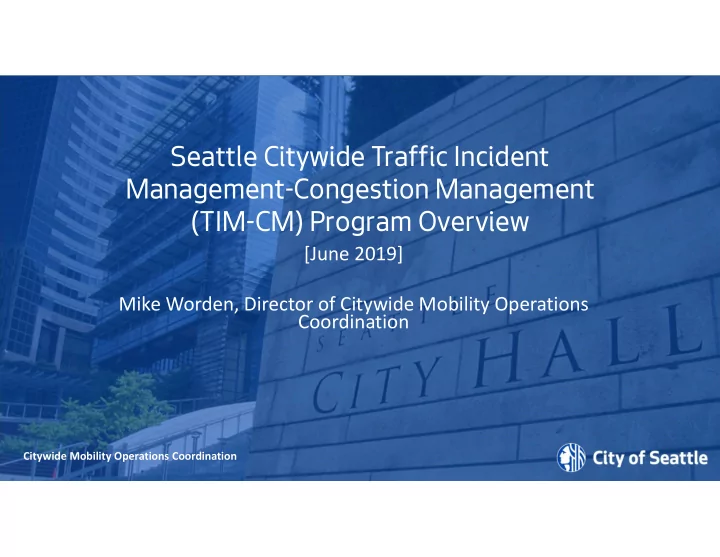

Seattle Citywide Traffic Incident Management-Congestion Management (TIM-CM) Program Overview [June 2019] Mike Worden, Director of Citywide Mobility Operations Coordination Citywide Mobility Operations Coordination Date (xx/xx/xxxx) Department Name Page Number Citywide Mobility Operations Coordination
• Traffic Incident Management (TIM) • "planned and coordinated multi-disciplinary process to detect, respond to, and clear traffic incidents so that traffic flow may be restored as safely and quickly as possible” • Congestion Management (CM) • “a systematic and regionally-accepted approach for managing congestion that provides accurate, up-to-date information on transportation system performance and assesses alternative strategies for congestion management that meet State and local needs" “A Congestion Management Plan (CMP) is required in metropolitan areas with population exceeding 200,000” Date (xx/xx/xxxx) Department Name Page Number Citywide Mobility Operations Coordination
Seattle’s Background: • Schwartz and Transafe Report – July 2015 (94 recommendations) • Casseday Report – November 2017 (20 recommendations) March 2015 “Fish Truck” Accident • Sept 2018 USDOT Review of TIM training • US DOT guidance on TIM Program Gap Analysis Seattle’s TIM Capability Maturity Self-Assessment Score (November 2017) Date (xx/xx/xxxx) Department Name Page Number Citywide Mobility Operations Coordination
Why TIM-CM Program? • TIM-CM Saves Lives • Currently two responders struck each day in US at scene of traffic incident • TIM training has led to 30-50% reductions in “secondary collisions” • Responder supervisor survey concludes – 78% personnel who attended TIM training “more safe” • TIM-CM Saves Time • Every minute major active artery lane is blocked = 4 minutes of travel delay • Average US traveler spent 97 hours in congested traffic, costing an average of $1,348 (lost labor) • TIM training, bolstered by Steer and Clear laws has led up to a 65% reduction in time to clear traffic • TIM-CM Saves Money • Collision damages averaged $784 per vehicle in 2010 • 2011 study showed congestion pollutes and costs 24 gallons of fuel for each driver annually • 2015 study showed freight incidents caused 996 million hours of delay equating to 362,243 truck drivers sitting idle for an entire year Saving just minutes on the scene aggregates to thousands of hours available for other types of work for police, fire, EMS (emergency medical services), transportation, and towing agencies Date (xx/xx/xxxx) Department Name Page Number Citywide Mobility Operations Coordination
Streamlining the Process Date (xx/xx/xxxx) Department Name Page Number Citywide Mobility Operations Coordination
Simultaneous Actions Date (xx/xx/xxxx) Department Name Page Number Citywide Mobility Operations Coordination
“commitment to continuous, measurable improvement and to implement relevant best practices” Date (xx/xx/xxxx) Department Name Page Number Citywide Mobility Operations Coordination
Seattle’s TIM-CM Program Governance Process Strategic guidance Executive Committee (semi-annual) – Dept/Agency Directors • Briefing and recommendation to close major action item • Review of rollup performance metrics and major recommendations for approval Leadership Committee (monthly-just before SAJOG) – Dept/Agency Designees • Preparation of major action item products, and program updates for review and approval by Executive Committee • Review and approval on minor action items (no budgetary or policy implications) • Review monthly traffic incident and congestion summary/metrics for improvement opportunities • Review performance metrics and best practices for improvement opportunities • Review training program and status • Prioritize action/workplan efforts and delivery schedule Joint Task Sub Committee (as required to close on task/action item) – SMEs Generate Product to complete action item and take to Leadership Committee Other stakeholders such as tow companies, KC Metro, etc. may be invited to select meetings Date (xx/xx/xxxx) Department Name Page Number Citywide Mobility Operations Coordination
Seattle Citywide TIM-CM 5-year Strategic Plan • Key Elements: • Vision – same as in 2015 MOU • Goals align with US DOT • Responder and traveler safety (6 objectives) • Safe, quick clearance of incident and efficient congestion management (3 objectives) • Prompt, reliable incident and congestion communications (3 objectives) • Objectives (measurable steps to achieve each goal) • Each objective has performance measure(s) • Action Plan (Workplan) • 5 categories: each category has short (2019-2020), mid (2021-2122), long (2023+) term deliverables • Training – initial and annual (refresher); procedures and best practices; inter-agency (updated annually) • Policy Manual – Citywide procedures and best practices (updated as needed/approved) • Public Outreach – staying connected with travelers • Inter-agency Collaboration - easy access to traffic-related information; SAJOG • Technology – builds awareness and collaboration Plan elevates Program from CMSA score of 1.5 (2017) to near 4.0 (highest level) Date (xx/xx/xxxx) Department Name Page Number Citywide Mobility Operations Coordination
Insert Smartsheet Workplan or Link Date (xx/xx/xxxx) Department Name Page Number Citywide Mobility Operations Coordination
Conclusions and Next Steps • A Robust Citywide TIM-CM Program in Seattle: • Allows all responders to know latest best practices in safely responding to incidents and more quickly clearing traffic • Saves lives, time, money, pollution • Allows us to more holistically measure our performance in each incident and improve • Frees traffic and responders more quickly to meet other needs • Next Steps: • Resume the TIM-CM Committee meetings and deliver on the Action/Workplan • Finalize Citywide Strategic Plan – especially training plan and publish policy manual • Improve and execute training • Leverage to shape Seattle Area Congestion Management Joint Operations Working Group (SAJOG) • Brief Mayor and Cabinet Everyone challenged to continuously improve in Traffic Incident and Congestion Management Date (xx/xx/xxxx) Department Name Page Number Citywide Mobility Operations Coordination
Recommend
More recommend